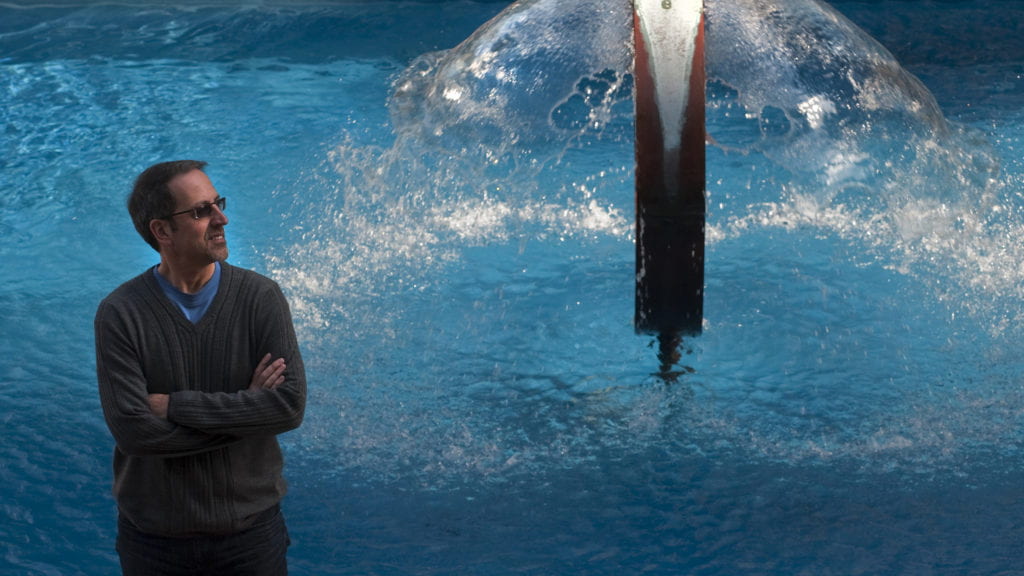Troubled waters
UCI hydrologist Jay Famiglietti stars in new documentary about water scarcity, pollution.
UC Irvine professor Jay Famiglietti sits with his arms politely crossed, watching an irate Central Valley farmer wrest a microphone out of a conservationist’s hand. The two are dueling over the urgency of irrigation for 25 percent of America’s food supply versus cancelling crop production to save water.
A few minutes later, Famiglietti patiently tries to explain the scientific reality behind groundwater depletion and why proper resource management could help all sides. Suddenly, he abandons his professorial lingo and sighs: “We’re screwed.”
It’s just one of his memorable observations in the new documentary “Last Call at the Oasis,” which was shown April 30 at the Newport Beach Film Festival, premiered May 4 in Los Angeles and other major markets, and will open May 11 at the Edwards University Town Center cinema in Irvine.
Directed by Academy Award winner Jessica Yu and produced by the same company that made “An Inconvenient Truth” and “Food, Inc.,” the movie chronicles dwindling water supplies worldwide, increasing pollution and potential solutions.
A professor of Earth system science and civil & environmental engineering who heads the University of California Center for Hydrologic Modeling, Famiglietti has collected global and regional data for years via a NASA satellite mission called GRACE (Gravity Recovery and Climate Experiment). He provides much of the research underpinning one of the film’s main messages – that humans are using up water faster than it can be replenished.
That’s a stark departure from the familiar cycle of precipitation taught to schoolchildren, in which raindrops fall from the sky, the water nourishes the Earth and runs into rivers that flow to the ocean, and then it evaporates back up into the clouds.
Thanks to rising atmospheric temperatures, Famiglietti and his graduate students explain, warmer clouds are beginning to hold more rain. They will unleash it in torrents that can’t be absorbed by lakes, dams and reservoirs.
Additionally, the Sierra snowpack and other natural storage systems are melting faster. In coming decades, some parts of the planet will be inundated, while other areas will experience unprecedented droughts. That accelerated cycle is now becoming visible from outer space.
“We can see significant depletion in California,” Famiglietti says, pointing to maps at NASA’s Jet Propulsion Laboratory, in Pasadena. “We’ve been keeping a close eye on the Central Valley. The view from the ground is muddied by politics. The view from space is clear and undeniable …. The aquifer has lost about one and a half times the volume of Lake Mead. That’s a huge amount of water.”
“I think California is in trouble,” he continues. “The combination of climate change, growth and groundwater depletion spells a train wreck.”
Such plain talk has earned the professor used to peer reviews a different kind of praise.
“The delightfully glum hydrologist Jay Famiglietti certainly doesn’t sugarcoat the topic, or our future,” wrote a Variety critic.
“Experts chiming in … include droll, deadpan UC Irvine hydrologist Jay Famiglietti,” read a San Francisco International Film Festival program note.
Producer Elise Pearlstein, who was nominated for an Academy Award for her work on “Food, Inc.,” said she’d read newspaper articles about Famiglietti’s work and was struck that he was researching both regional and global water supplies, from Sacramento to Northern India.
“It was one-stop shopping,” Pearlstein said at a pre-screening of the film April 20 at UCI. She added that it was a pleasure working with someone more concerned about the subject matter than about rolling cameras.
For his part, Famiglietti says making the movie was a fantastic experience. “Elise and Jessica are extremely dedicated, wonderful storytellers and filmmakers. The final result exceeded anything I ever could have anticipated.”
He has had not just his name but also his research up in lights recently. Data from his GRACE project was displayed on Thomson Reuters’ electronic Times Square billboards for most of April. It’s all part of his mission to try to educate the public about what is happening.
Famiglietti knows that because the change in water supply is occurring in slow motion, over a period of decades, “it’s a very difficult thing for people to grasp.”
On a cross-country flight in 2010, he had an epiphany, realizing that his team’s ongoing findings added up to the fact that the age-old water cycle was being altered for the worse. Famiglietti knew instantly that he needed to act.
“It’s been like watching a Polaroid develop,” he says in the film, as a graphic of Earth with pulsing blue, green and red areas swells behind him. “All of a sudden, you have a complete picture. It’s like an ‘Oh, my God’ moment. You think, ‘I can’t believe this is happening – and I need to tell somebody about it.’”

